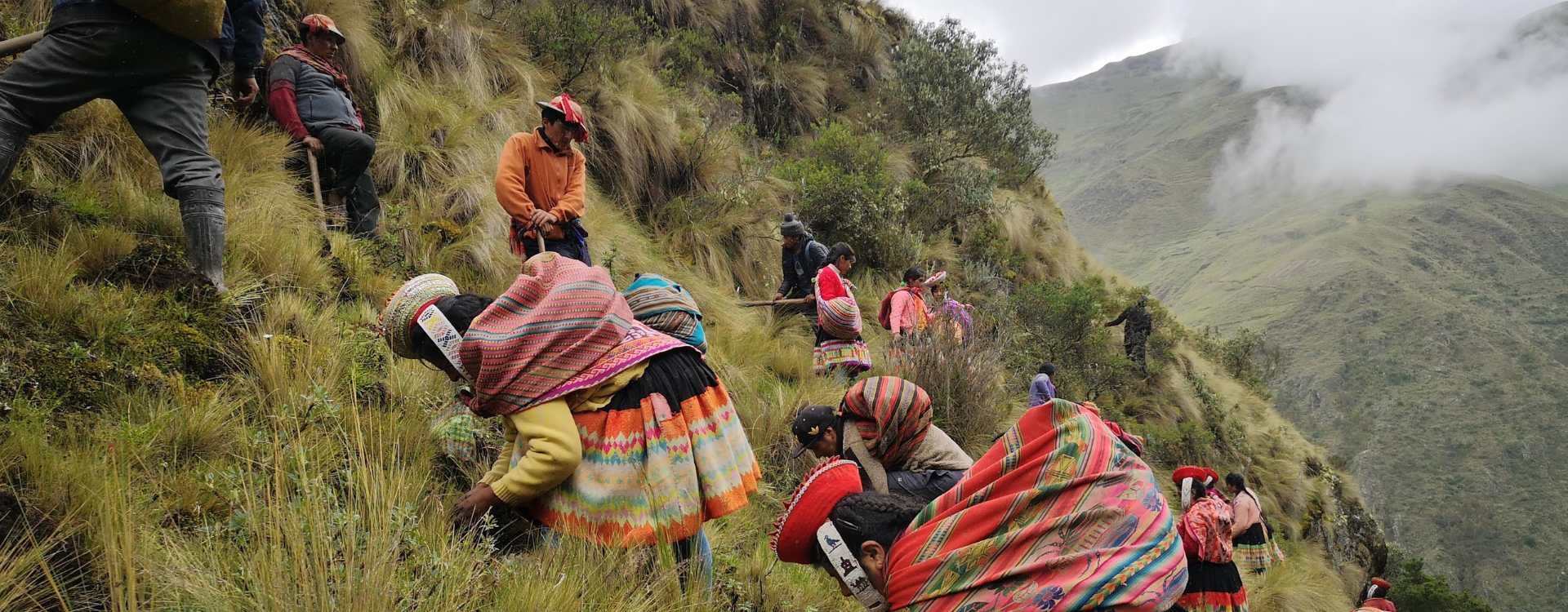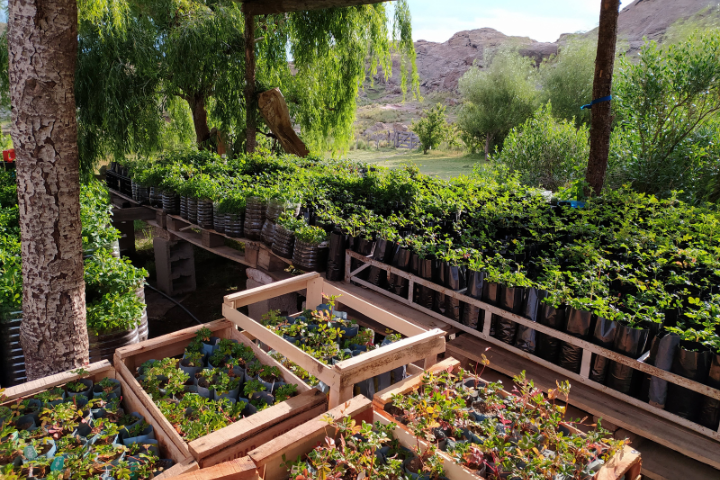Harking back to the Inca’s golden past to plant a greener future
April 7, 2025 | By Sophie Hares
As Peruvian biologist Constantino Aucca Chutas sat chewing coca leaves with a local elder high in the Andes, his companion pointed to a peak known as Demon Mountain and shared how its rocky slopes were once snow-covered.
The elder explained how Pachamama, or Mother Earth, grew so annoyed with humans that she stopped sending snow. Planting trees was the only way to harness much-needed water for the farmers in the valleys below.
Looking across the pass to the bare mountain, Aucca began thinking of how he could combine his understanding of biodiversity with the knowledge of Indigenous communities to help reforest the mountains and repair vulnerable ecosystems.
“A thousand years ago we were once part of the magnificent Inca Empire, which also suffered climate change. They planted millions of trees to manage the weather,” says Cusco-based Aucca. “We did it then by working together for a common goal.”
Following their lead, Aucca vowed to unite his community together once more to plant millions of trees that would generate water for all. He and three colleagues founded the Peru-based Asociación Ecosistemas Andinos (ECOAN) in 2000 and began reviving the High Andean ecosystems of his homeland.
Determined to expand his work across the Andes, Aucca joined forces with three other conservation leaders to co-found Global Forest Generation (GFG) in 2018 and launch Acción Andina, an ambitious initiative to restore forests and secure water resources throughout the region. Shortly after, Florent Kaiser became the leader of GFG, helping to solidify Aucca’s vision.
Under this model, ECOAN would contribute its deep expertise in ecosystem restoration and unite grassroots conservation leaders already working to protect fragile High Andean landscapes. Global Forest Generation would provide the global partnerships, funding and technical support needed to scale these efforts, empowering local organizations to achieve more than they could alone.



Accion Andina, with support from the Priceless Planet Coalition, is planting Polylepsis saplings, native to the High Andes, raised in nurseries by local communities, like the one in Cordoba, Argentina, left. Constantino Aucca Chutas, right, co-founded Acción Andina and organizes tree-planting events, center, accompanied by music and dancing. (Photos courtesy of Acción Andina)
Fast-forward to 2025 and Acción Andina has planted 12 million native Polylepis trees and wants to protect and restore a million hectares along the mountainous spine of South America, which extends from northern Venezuela, on the Caribbean Sea, to ice-glazed Patagonia in the south.
Last year, the Mastercard-led Priceless Planet Coalition, which aims to restore 100 million trees worldwide, expanded its planting sites to include nearly 1,000 acres in Peru and Ecuador, with a target of 1.1 million trees. By the end of 2024, 579,306 trees had been planted by five local partners representing 11 Acción Andina projects.
With the Andes having lost some 95% of its native forests and up to 50% of its glaciers, the project aims to build climate resilience using a community-based model that honors local knowledge. The broader goal is to adapt this model to other ecosystems around the world while respecting each geography’s unique local culture and developing conservation tools that meet community needs.
Through its work, involving 26 projects, some 40,000 people are now directly involved in Acción Andina’s efforts to plant native trees that absorb rain and glacial meltwater, helping to reduce the damaging cycle of floods and droughts.
“It’s not a conservation or a tree-planting project,” Kaiser says. “It is a massive, century-long effort to increase water security across the Andes by reviving these ecosystems.”
During a community reforestation event, members of local Indigenous communities in Vilcanota, Peru, trek into the mountains to plant saplings, above and in banner photo. (Photo credit: Luis Torres)
But initially, convincing local communities to get on board was challenging. It was a tough ask of farmers, who were already struggling to survive climate-induced droughts and wildfires, to throw their energy into conservation.
Tapping into the ancestral concepts of ayni and minka, which together mean “today for me, tomorrow for you,” Aucca reminded communities of their Inca heritage and how they fought for independence from the Spanish. Protecting the environment was their next battle, and they would fight by planting trees. Aucca organized the first of many tree-planting events. Heralded by musicians blasting trumpets and giant shells, hundreds of people trek up the mountains to plant tens of thousands of trees in a single day, interspersing the backbreaking work with music and dancing.
While native Polylepis trees are slow-growing, each hole people dig to plant them helps funnel water into the mountainside. At less than two feet tall, the saplings start to create mini ecosystems as their moss-covered branches absorb humidity and attract bugs and birds.
Engaging with local communities and supporting livelihoods remains a focus and priority of the project. The production of the seedlings, which cost about $1.50 each, are bought from local nurseries that use the income for community projects, such as repairing village schools or installing solar panels. With funding from the Coalition, Acción Andina has also held educational workshops to teach communities how to improve water catchment systems and built a drip irrigation system that will help hundreds of families in a village in Peru with more sustainable infrastructure.
Now recognized with the prestigious 2023 Earthshot Prize and as a U.N. World Restoration Flagship in 2024, Acción Andina is exploring how to combine traditional knowledge with artificial intelligence and high-tech imaging to identify the best locations for tree planting to protect vital watersheds, including those that sustain Lima and Quito.
The Priceless Planet Coalition’s work, in partnership with Conservation International and the World Resources Institute, is targeting these regions, with the aim of securing the future of these vital water sources and carbon sinks, creating jobs, building leadership capacity, preventing forest fires and protecting biodiversity. The High Andean forests provide key habitat for more than 40 species of conservation concern, according to the International Union for Conservation of Nature.
The coalition, whose partners contribute resources and run awareness campaigns that educate consumers on the importance of locally led tree restoration projects, is proving that the private sector has an essential role in supporting local communities as they take on ambitious cross-border projects.
Kaiser echoes this emphasis on collaboration, highlighting that partnerships across generations, nations and sectors have been key to Acción Andina’s success. “What makes Acción Andina so powerful is the deep sense of community that drives it," he says. "The friendships and partnerships we have built over the years, including with the PPC, have allowed us to grow in ways we never imagined. Acción Andina is an inspiring symbol of what can happen when people come together under a shared purpose."